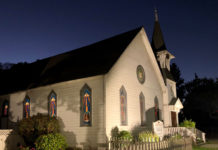Members of the Church of Jesus Christ of Latter-day Saints are a highly respected part of their communities throughout the United States. They hold important positions in government, business, education and other fields. But this was not always the case.
When the church was founded in the early 19th century, members faced fierce hostility, including rioting mobs and lynchings. Eventually they braved the perils of weather and wilderness, fleeing to build a society in Utah.
This history helps explain one of the characteristics of the LDS Church, a hardy self-reliance. Members are encouraged to “prepare for adversity in life,” and the Church has established a sophisticated welfare system that has may aspects to help Mormons through tough times.
Recently I visited a bishop’s storehouse in an industrial area of San Jose, one that serves the area from San Jose to King City. This vast warehouse is basically a food bank with inventory available to Mormon bishops (spiritual leaders of local “wards” or congregations) to distribute to people needing food assistance due to financial difficulties.
An amazing variety of products is available, approximately $1 million in wholesale value last year. Some 100 families receive groceries in an average week, more than 200 in the week before Thanksgiving. Items include:
• Fresh produce from local farms
• Frozen meat from church ranches
• Fruits and vegetables harvested on church farms and canned in church facilities (under the “Deseret” brand)
• Commodities like rice, flour and sugar.
This whole operation is staffed by volunteers, local members who serve periods of time as a “calling” and missionaries who are assigned to work there as part of their mission service. Funds come from members’ tithes and fast-offerings. Since Mormons don’t believe in receiving something for nothing, most recipients of aid volunteer to work in some capacity, as they are able.
The resources of this storehouse are not available only to Mormons; any bishop can authorize aid for non-members, and the storehouse regularly provides “humanitarian aid” to charities like the Second Harvest Food Bank. On the day of my visit, a truck from Gilroy’s St. Joseph’s Family Center arrived to collect a supply of food for distribution in Christmas baskets to South Valley’s needy.
Sharing space with the storehouse is a home storage center. Until recently, people could bring their own food (wheat, rice, fruit, vegetables) and preserve it themselves. This system has been replaced by bulk supplies sent here that can be purchased inexpensively for use in emergency storage supplies. This helps members follow a church suggestion that they keep a three-month supply of food in their homes in case of natural disaster.
Bishops also have access to other goods for needy members. Deseret Industries, a church-owned company, operates warehouses with furniture, toys and household items that can be provided to members in need, especially at Christmas time or following a disaster.
Deseret Industries also collects unwanted household goods and sells them through a chain of thrift stores that provide opportunities for training and employment. The Bay Area storehouse is expanding to a much larger facility in 2014 that will also include employment services resources.
Mormons are taught that “each person’s spiritual and temporal well-being rests first upon himself, second upon his family and third upon the Church.” But circumstances can change, making people unable to support themselves. (Anyone can fall victim to unemployment, serious illness or death of a family members.) It is through established programs designed to build self-reliance, emergency preparedness, service to others and individual growth that the LDS Church demonstrates a remarkable ability to help members help themselves as well as their neighbors when the need arises.
For more information, visit www.providentliving.org or call (408) 230-0947.







